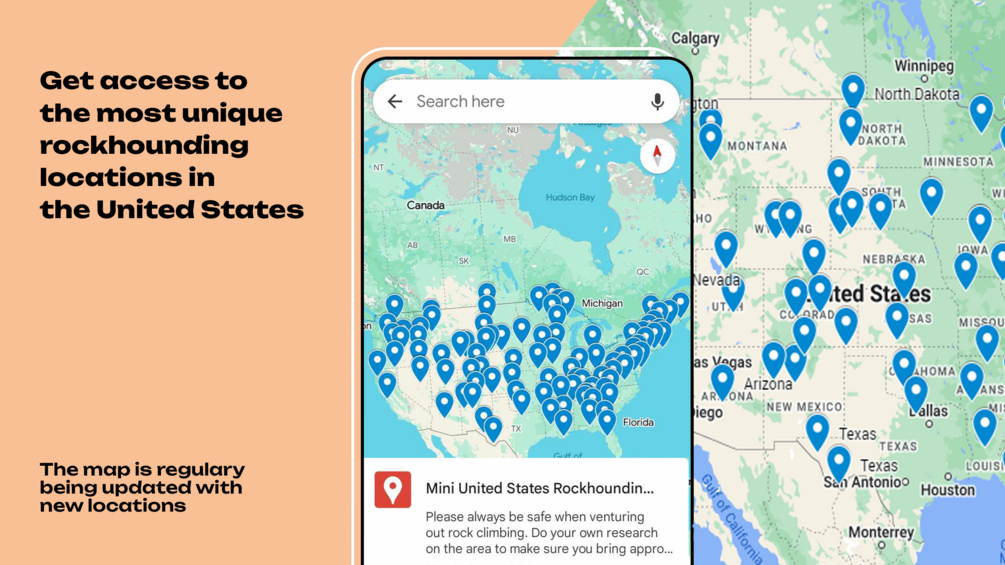Ready to uncover the hidden gems of Connecticut?
You’re in for a treat! The Constitution State offers a treasure trove of rockhounding sites where you can dig into geology and come away with some stunning finds.
From the rolling hills of the northwest to the tranquil beaches of the coastline, Connecticut’s diverse landscapes are a rockhound’s paradise. You’ll discover a variety of minerals, crystals, and fossils, each with its own unique charm and story.
Whether you’re a seasoned collector or just starting out, the thrill of the hunt is calling.
Grab your gear and let’s explore the best spots to rockhound in Connecticut and the amazing treasures you can find.
Rockhounding in Connecticut offers diverse gems, fossils, and rocks across regions. Remember permission, proper gear, safety, and responsible collection are key.
Get our FREE United States Rockhounding Map HERE

Connecticut Rockhounding Locations
Embarking on a rockhounding adventure in Connecticut means you’re in for a treat. The state boasts numerous sites that cater to enthusiasts of all levels. Whether you’re a seasoned rockhound or just looking for a unique weekend activity, you’re bound to find something special to add to your collection.
Case Quarries, East Haddam
At this former feldspar and mica mine in the town of East Haddam, you can uncover a wealth of minerals. Noteworthy finds include gem-quality beryl and quartz. Remember to wear sturdy gloves and bring a reliable pick or hammer, as extracting these treasures requires some effort.
Squantz Pond State Park, New Fairfield
Rockhounding near water bodies can be incredibly satisfying, and Squantz Pond State Park offers just that. The park’s diverse geological structure is a prime spot for finding garnets and tourmaline. The scenic view is a bonus while you scour the grounds for these striking, colorful minerals.
- Garnets
- Tourmaline
Green’s Farm Garnet Mines, Roxbury
If you’re after garnets specifically, Green’s Farm Garnet Mines shouldn’t be overlooked. This locality is renowned for its garnet deposits, nestled within the rolling hills. Their deep-red hue is a coveted find, and the mine’s history adds an extra layer of excitement to your search.
For those new to rockhounding, education is key. Understanding the types of rocks and the best methods for extraction can greatly enhance your experience. Dive into local rockhounding guides or join a community of enthusiasts to learn the tricks of the trade before you set out.
And don’t forget about the ethical aspect of rockhounding. Always adhere to the local laws and regulations and practice Leave No Trace principles to ensure locations remain accessible and preserved for future rock enthusiasts. Happy hunting as you explore Connecticut’s rich land and remember, your next great discovery is just waiting to be unearthed.
What Gemstones are Found in Connecticut?

Discovering the plethora of gemstones nestled in the landscapes of Connecticut is an exhilarating experience for any enthusiast. The state, known for its mineralogical diversity, is a hotbed for a variety of coveted gemstones. As you wander through the scenic terrain, prepare to uncover the raw beauty of Connecticut’s geological treasures.
Garnet, a group of silicate minerals known for their use in jewelry and abrasives, is found in abundance throughout Connecticut. Most notably, Almandine garnet is the variety often seen in Roxbury and New Fairfield. These garnets aren’t just for seasoned collectors; they provide an excellent starting point for novices too.
Next on the list is the stunning Aquamarine. This blue to green-blue variety of beryl is highly sought after and can be found at the famous Case Quarries in East Haddam. Known for their clarity and size, the aquamarine crystals found here can make a dazzling addition to any collection.
Another gemstone that’s placed Connecticut on the map among rockhounds is the Schorl Tourmaline. This black, iron-rich member of the tourmaline family can be found at various sites across the state, including Haddam Neck and New Fairfield. Its striking three-sided prismatic crystals attract collectors who appreciate its unique aesthetic.
In addition to these, rockhounds in Connecticut may also stumble upon:
- Quartz varieties, including clear, smoky, and rose quartz
- The mineral Beryl, in colors other than aquamarine
- Rare finds of Spessartine, a type of garnet in a vibrant orange hue
The geological backdrop of Connecticut continues to be an endless source of surprise and fascination. With each stone unearthed, you’ll get a glimpse into the state’s rich geologic past and perhaps, find that special piece that speaks to the wonders beneath our feet. Each site offers its unique geological composition, ensuring that every excursion might lead to a new and exciting discovery. Always remember to research the local guidelines and seek appropriate permissions as you seek out these natural treasures.
What Sedimentary Rocks You Can Find in Connecticut?

Exploring Connecticut’s geological landscape reveals a variety of sedimentary rocks that have been shaped by time and the environment. As you traverse this diverse state, you’ll find that sedimentary rocks are not as abundant as the metamorphic and igneous types, but they are still present and hold their own allure for rockhounds.
Brownstone, a type of sandstone, is prominently featured in Connecticut’s architectural history. This rock was once quarry-mined in the Portland area and used extensively in the 19th century for building construction. Its warm, reddish-brown hue is distinctive, and while the quarries are no longer operational, discarded pieces can often be found scattered around old quarry sites.
Shale, another sedimentary rock, can be located in certain areas. Shale is formed from compacted mud and can sometimes contain fossils, offering a tangible link to the ancient past. The best places to look for shale are in river valleys and along stream beds where erosion has exposed older rock layers.
The sedimentary rock layers in Connecticut also offer a snapshot of the past environments. These layers can tell you a lot about the state’s geological history. In some locations, you might come across Limestone, a rock that forms from the accumulation of shell, coral, algal, and fecal debris. It can also form through the precipitation of calcium carbonate from lake or ocean water.
- Brownstone
- Shale
- Limestone
When rockhounding for sedimentary rocks, it’s essential to be mindful of property rights and local regulations. Always obtain permission when necessary and take care not to disturb natural habitats. Remember that many sedimentary rocks are best left in their natural environment for others to enjoy.
Remember, with sedimentary rocks, you’re not just finding a stone; you’re uncovering a piece of Earth’s history. The thrill of discovery is what keeps rockhounds returning to the field, eager to find a rock that tells a story millions of years in the making. Keep your eyes peeled for the unique textures and structures that make sedimentary rocks a fascinating addition to your collection.
What Metamorphic Rocks are found in Connecticut?
As a rockhound in Connecticut, you’ll be delighted to know that the state is rich in metamorphic rocks. Among these, schist and gneiss are particularly abundant, intricately woven into Connecticut’s geological tapestry. When you’re exploring the outdoor nooks and crannies, you’ll likely encounter various types of schist, ranging in color and composition. These rocks commonly contain beautiful garnet crystals, giving them an additional allure.
You may also stumble upon marble, especially in the northwestern parts of the state. Historically, Connecticut marble has been valued for its high quality and was even used in constructing the iconic State Capitol. While less abundant than schist and gneiss, marble finds can be truly rewarding due to their historical significance and pure beauty.
Here’s a quick reference for what you might uncover:
- Schist
- Rich in garnet
- Varied colors
- Gneiss
- Striped or banded appearance
- Marble
- Historically significant
- Prized for architectural use
Embedded within the layers of gneiss, you may also find intriguing mineral deposits such as bertrandite and the state’s official mineral, garnet. These finds can enhance your collection with unique specimens that capture both the geological narrative and the mineral wealth of Connecticut.
Geological sites such as Haddam Meadows State Park or the Garnet Ledges in Roxbury are promising for enthusiasts looking for metamorphic varieties. Remember that while you’re scouring these areas, respect for the natural environment is paramount. Always ensure you leave no trace of your exploration activities behind.
Rockhounding in Connecticut is not just about adding to your collection; it’s about the excitement of decoding Earth’s transformative history. With every piece you find, you’re holding a story millions of years in the making. So, equip yourself with the right tools, a keen eye, and an appreciation for the state’s rich geologic foundation, and you’re set for a thrilling adventure.
What Igneous Rocks can You Find in Connecticut?
Venturing into the realm of igneous rock formations, Connecticut’s geological landscape doesn’t disappoint avid rock collectors. One of the most remarkable igneous rocks found in the state is the pegmatite. Pegmatite is known for its exceptionally large crystal sizes and is often the host for a variety of rare minerals. You’ll find these coarse-grained rocks mostly in the Haddam area, a location celebrated for its mineral diversity.
In Litchfield County, the quest for igneous specimens leads to the discovery of basalt, a fine-grained volcanic rock. Renowned for the famous Dinosaur State Park, this region showcases basalt laden with tracks left by prehistoric creatures. The dark, dense rock is a solid clue of the ancient volcanic activity that shaped much of Connecticut’s terrain.
Another prized find is the porphyritic granite, characterized by its larger crystals, or phenocrysts, embedded in a fine-grained matrix. This igneous rock is predominantly found in the Branford and Guilford areas. Its attractive appearance makes it a favorite among rockhounds seeking both aesthetic and scientific value.
These areas are ripe with opportunities to unearth Connecticut’s igneous treasures:
- Haddam for Pegmatite
- Litchfield County for Basalt
- Branford and Guilford for Porphyritic Granite
Remember, rockhounding in these regions requires keen observation and a gentle touch. Safety is paramount, so ensure you’re equipped with the proper gear and permissions needed for a successful and responsible hunt.
By understanding these igneous rock locations and characteristics, you’re better prepared to spot and identify the geological wonders that lie beneath your feet. Keep a keen eye on the ground; your next discovery could be a tangible piece of Connecticut’s fiery geological past.
Panning for Gold in Connecticut
When embarking on a gold panning adventure in Connecticut, you’re joining a centuries-old quest that dates back to the 1800s. The state isn’t known for commercial gold mining, but recreational panners can still find fine flakes and occasional nuggets in its rivers and streams. Remember, patience is key, and perseverance often pays off.
Prime Locations for Panning
The western part of Connecticut is your best bet for panning success. Leadmine Brook in Thomaston and the adjacent Naugatuck River are prime examples. Consider the areas around Still River in Fairfield County and Spruce Brook in Wolcott. These streams are known for their historical placer gold.
Necessary Equipment
You’ll need a few basic tools:
- A gold pan
- A sluice box (for more serious endeavors)
- A classifier or sieve
- A snuffer bottle
- A vial to hold your findings
Ensure your equipment is decent quality to avoid unnecessary frustration.
Legal Aspects
It’s crucial to stay on the right side of the law when panning for gold. Always seek permission if you’re venturing onto private land and be aware of Connecticut’s environmental regulations to protect local habitats.
- Look for gold where water slows down, such as behind large rocks or in natural troughs.
- Clear away larger rocks and gravel before panning.
- Gold is heavier than most other minerals, so it tends to sink. Keep your pan close to the water and use a gentle swirling motion to encourage the gold to settle at the bottom.
- Stay patient—finding gold can take time, and the experience of being in nature is rewarding in itself.
Exploring Connecticut’s waterways for precious metals adds an exciting layer to the rockhounding experience. It offers a memorable connection with the past and a hopeful glance toward the glitter of success. Keep these tips in mind, respect the natural environment, and immerse yourself in the adventure that gold panning presents.
Rocks and Minerals Found in Connecticut
Rockhounding in Connecticut opens up a world where the ground beneath your feet is teeming with geological treasures. The state’s diverse geology makes it a prime spot for collectors and enthusiasts alike. You may be surprised at the variety of minerals and rocks just waiting to be discovered.
Garnet, the state mineral, is a frequent find, particularly within the mica schists throughout the state. Almandine garnet, known for its deep red hue, can often be spotted by its distinctive dodecahedral crystal structure. In contrast, the beryl family makes its presence known with stunning aquamarine and golden beryl, lending a splash of color to your collection.
Quartz is abundant in varying forms – from clear crystals to milky quartz and even the rare smoky quartz. These can be fantastic finds, both for their beauty and for their prevalence, making them accessible for rockhounds of all experience levels. Beyond these, the Litchfield Hills are a hotspot for finding mineral specimens like tremolite, tourmaline, and magnetite.
Enthusiasts seeking a more unique addition might set their sights on Connecticut River Valley where dinosaur tracks can be spotted in sandstone, a testimony to the state’s ancient past. For those with a keen eye, seeking fossils can be as rewarding as the pursuit of precious stones.
Before you head out, it’s crucial to arm yourself with knowledge about access rights and property laws. Many sites are on private land or protected areas, so obtaining permission and adhering to local regulations is a must to ensure a lawful and fruitful rockhounding excursion.
Armed with your gear and research, you’re ready to uncover Connecticut’s geological riches. Whether you’re combing the banks of a river or exploring an old quarry, the state’s geology rewards those who are persistent. Dive into your rockhounding adventure and let the land showcase its hidden gems.
Where Can I Find Fossils in Connecticut?
Your quest for fossils in Connecticut can be as exciting as stepping back in time. This state, rich in geological history, offers prime locations where you can unearth remnants of ancient life. Dinosaur State Park in Rocky Hill is one of the most notable sites. Here, you’ll find an exceptional display of fossilized dinosaur tracks, frozen in time for about 200 million years. These tracks were left by carnivorous dinosaurs and are one of the largest on-site displays of its kind in North America.
Another fossil hotspot is the Connecticut River Valley, particularly near the towns of Hadlyme and Portland. In this region, known for the famed “Portland Arkose,” prehistoric fish fossils and unique imprints of ancient plants are nestled within sedimentary rocks. Searching along riverbanks and cutaways could reveal these hidden treasures.
- Dinosaur State Park, Rocky Hill: Massive collection of dinosaur tracks
- Connecticut River Valley, Hadlyme & Portland: Prehistoric fish fossils and plant imprints
It’s crucial to know that most fossil sites are within areas protected by state laws. Before you begin, ensure you’re aware of the regulations and have the necessary permissions. Moreover, fossil hunting in Connecticut is usually more fruitful after heavy rains as the water can expose new layers of rock. Always approach your hunt with patience and respect for the land.
As you go rockhounding for fossils, you might also come across some of Connecticut’s mineral wonders. Whether it’s the lustrous garnets, the translucent beryl, or the myriad forms of quartz, your fossil hunt could unexpectedly turn into a mineralogical adventure. Just remember to equip yourself with the proper tools and safety gear, including goggles, gloves, and a sturdy hammer, to maximize your rockhounding experience. Keep a keen eye out, and you may just find a fossil that whispers of Earth’s ancient past.
Connecticut Rockhounding Laws & Regulations
Before you head out with your hammer and chisel, it’s crucial to understand the legal landscape of rockhounding in Connecticut. Being aware of the laws and regulations will ensure you’re rockhounding responsibly and legally.
The first thing to keep in mind is that land ownership matters. If you’re planning to explore private lands, you must obtain explicit permission from the landowner. Trespassing to collect rocks and minerals is illegal and can result in hefty fines or even arrest. For public lands, check with the local town hall or the Connecticut Department of Energy and Environmental Protection (DEEP) for any specific rules they may have in place.
When it comes to state parks and forests, collecting for commercial purposes is not allowed without a proper permit. Recreational collecting, however, is generally permitted on a small scale. This means you’re fine to collect a few specimens for personal use, but bulk collecting or using heavy equipment is a no-go.
- Always check the most recent regulations for the area you plan to visit.
- Abide by the American Federation of Mineralogical Societies’ Code of Ethics which encourages respect for property, nature, and other collectors.
In some areas, collecting may be restricted to protect endangered species or historic artifacts. Always be vigilant and avoid disturbing the surrounding environment.
Remember, Connecticut’s geology offers priceless natural history lessons. While you’re free to enjoy these treasures, it’s your responsibility to preserve them for future generations. Stick to the rules, respect the land, and enjoy your search for Connecticut’s geological wonders without the worry of legal repercussions. Keep this guide in mind and you’re set to explore Connecticut’s rich mineral offerings with peace of mind.
Rockhounding Tips for Beginners in Connecticut
When you’re just starting out with rockhounding in Connecticut, it’s key to know the ropes to maximize your experience. Whether you’re on a quest for quartz or in pursuit of prehistoric footprints, these tips will ensure you’re well-prepared, safe, and within the bounds of the law.
Gearing Up: Essential Tools for Rockhounding
Before venturing out, make sure you’ve got the right gear. Here’s what you’ll need:
- Rock Hammer: Ideal for chipping samples or splitting rocks.
- Chisels: To help carefully pry rocks from their locations.
- Safety Goggles: Protect your eyes from flying debris.
- Gloves: A sturdy pair to safeguard your hands.
- Bucket or backpack: To carry your finds.
- Field Guide: For identifying minerals and rocks.
- GPS or Detailed Map: To navigate remote areas safely.
Arm yourself with this equipment and you’re more likely to have a successful outing. Remember, the right tool not only makes the job easier but also prevents damage to the specimens you collect.
Safety Tips While Rockhounding
Your safety should always come first. Keep these in mind:
- Stay within designated areas, especially in parks and public lands.
- Never rockhound alone; having a partner ensures help is at hand in case of any emergencies.
- Stay aware of your surroundings, watching for wildlife, hazardous terrain, and potential weather changes.
- Keep hydrated and have enough snacks. Some locales might not have immediate access to amenities.
- Check the forecast before heading out and prepare for Connecticut’s quickly changing weather.
Following these tips helps ensure that your rockhounding adventure doesn’t lead to accidents or injuries.
Legal Guidelines for Rockhounding Enthusiasts
Adhering to the law is paramount when rockhounding. Here’s what you need to remember:
- Always seek permission before entering private property.
- Collecting in state parks and forests comes with specific limitations—and in some cases, is not allowed, so check the regulations.
- Be mindful of the size and amount of material you collect; overcollecting can deplete resources and impact the environment.
Abiding by these regulations not only keeps you on the right side of the law but also helps conserve Connecticut’s rich geological heritage for future generations.
Conclusion: Connecticut Rockhounding Guide & Map
Embarking on your rockhounding adventure in Connecticut can be a thrilling and rewarding experience.
With the right gear and a keen awareness of safety and legal guidelines, you’re set to explore the state’s rich geological landscape. Remember to always respect the environment and property rights to help preserve these natural treasures for future generations.
Happy hunting and may your collection grow with each new discovery!






![NJ Rockhounding Sites in [year]: Locations & Treasures](https://observationhobbies.com/wp-content/uploads/2024/01/ugMmbaQ3jtMbGgQd582Om-768x439.jpg)
